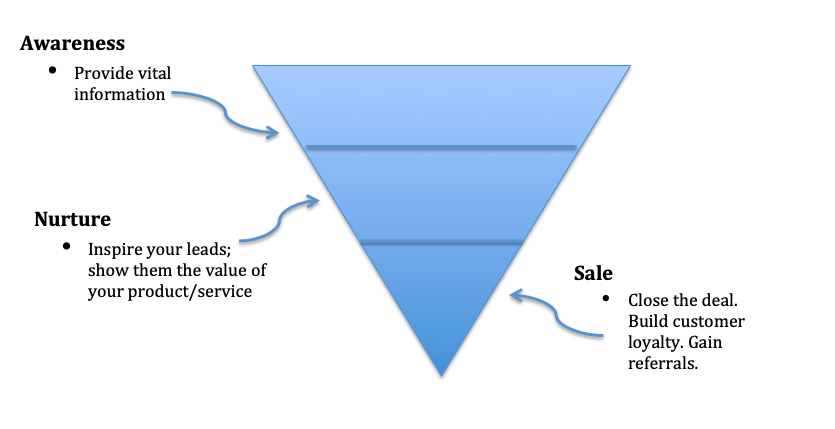What Is a Sales Funnel and Why Does it Matter?
Even if you don’t refer to it as a “sales funnel,” you’re probably already using sales funnels on a daily basis for your business. “Funnel” is a funny word that conjures images of science experiments or kitchen equipment, but the sales funnel is simply a process that companies use to guide their customers from the first interaction to purchase.
Picture a funnel shape in your mind. The sales funnel is made up of sections that illustrate how the customer is progressing through his or her journey. These sections include Top, Middle, and Bottom. While the Top (the widest part of the funnel) represents the moment you first meet your customer, the Bottom (the most narrow part of the funnel) symbolizes the moment your customer finally makes the purchase.
Within each section, you’ll want to accomplish specific goals to move your customers further down the funnel. At the Top of the funnel, you’ll want to create awareness of your products and services – and then continue nurturing that awareness throughout the process. Do your customers know who you are and what you do? At the Top is the time to provide them with vital information.
In the Middle of the funnel, you’ll want to inspire your customers to become interested in you. Consider two people on a date. When one person is interested, he or she may start leaning forward to listen more carefully and start asking more substantial questions. In the same way, you want your customers to be curious and intrigued. Also, in the Middle of the funnel, the customer will start to wonder if your product or service is a good fit and worth the investment.
At the Bottom of the funnel, your customer will have already made his or her decision. Now, you must close the deal and deliver the customer with exceptional service and/or a top-notch product. Many people wrongfully assume that the funnel ends there. However, at the Bottom of the funnel, you’ll also want to nurture customer loyalty, so your customer returns and refers more customers to you.
Why should you care about the funnel? Understanding how the funnel works and being aware of where your customers are in the funnel will help you adjust how you interact with them. At the Top of the funnel, the entry point is wide, and many people enter. You won’t want to invest too much one-on-one time with these Top-of-funnel prospects because you don’t know how many will move forward. As the funnel gets smaller, you’ll want to spend more time and money on nurturing your customers, so they become loyal fans.
Using a tool like FollowUp can help you manage your contacts and track where they are in the funnel. With our tool, you can schedule follow-ups to ensure your conversations don’t slip through the cracks. What are some techniques you use to track the customers in your sales funnel?
Latest posts by David Candelas (see all)
- Use a SMART Goal Template to Hack Your Productivity - December 11, 2020
- Is LinkedIn Worth Your Time as a Salesperson? - November 24, 2020
- Tips for Starting the Home Office of Your Dreams - November 29, 2019


